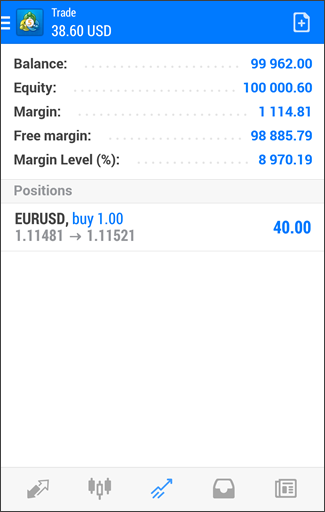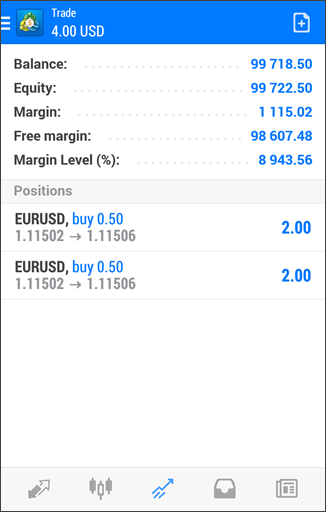Common Trading Principles
Before you proceed to study the trade functions of the platform, you must get a clear understanding of the basic terms: order, deal and position.
- Order
An order is an instruction given to a broker to buy or sell a financial instrument. There are two main types of orders: market and pending. In addition, there are special Take Profit and Stop Loss orders.
- Deal
A deal is the commercial exchange (buying or selling) of a financial security. Buying is executed at the demand price (Ask), and Sell is performed at the supply price (Bid). A deal can appear resulting from the execution of a market order or triggering of a pending order. Keep in mind that in some cases, execution of an order can result in several deals.
- Position
A position is a trade obligation, i.e. the number of bought or sold contracts of a financial instrument. A long position is financial security bought expecting the security price go higher. A short position is an obligation to supply a security expecting the price will fall in future.
General Scheme of Trade Operations
- From the trading platform, an order is sent to a broker to execute a deal with the specified parameters.
- On the server, correctness of an order is checked (correctness of prices, availability of funds on the account, etc.).
- Orders that have passed the check wait to be processed on the trade server. Then the order can be:
- executed (in one of automatic execution modes or by a dealer)
- canceled upon expiry
- rejected (e.g. when money is not enough or there is no suiting offer in the market; or rejected by the dealer)
- canceled by a trader;
- Execution of a market order or triggering of a pending order results in a deal;
- If there are no positions for a symbol, conclusion of a deal results in opening of a position. If there is a position for the symbol, the deal will lead to increase or reduction of the position volume, its closure or reversal.
 Scheme of trade operations |

|
Position Accounting System #
Two position accounting systems are supported in the trading platform: Netting and Hedging. The system used depends on the account and is set by the broker.
Netting System #
With this system, you can have only one common position for a symbol at the same time:
- If there is an open position for a symbol, executing a deal in the same direction increases the volume of this position.
- If a deal is executed in the opposite direction, the volume of the existing position can be decreased, the position can be closed (when the deal volume is equal to the position volume) or reversed (if the volume of the opposite deal is greater than the current position).
|
It does not matter, what has caused the opposite deal – an executed market order or a triggered pending order.
The above example shows execution of two EURUSD Buy deal 0.5 lots each.
As a result of execution of these two trades, one total 1-lot position is opened.
|
Hedging System #
With this system, you can have multiple open positions of one and the same symbol, including opposite positions.
If you have an open position for a symbol, and execute a new deal (or a pending order triggers), a new position is additionally opened. Your current position does not change.
An example to the left shows execution of two EURUSD Buy deal 0.5 lots each:
As a result of execution of these two trades, two separate positions are opened.
Impact of the System Selected
Depending on the position accounting system, some of the platform functions may have different behavior:
|

|
- To close a position in the netting system, you should perform an opposite trading operation for the same symbol and the same volume.
- In order to close a position in the hedging system, explicitly select the "Close Position" command in the context menu of the position.
- A position cannot be reversed in the hedging system. In this case, the current position is closed and a new one with the remaining volume is opened.
- In the hedging system, a new condition for margin calculation is available – Hedged margin.
|


